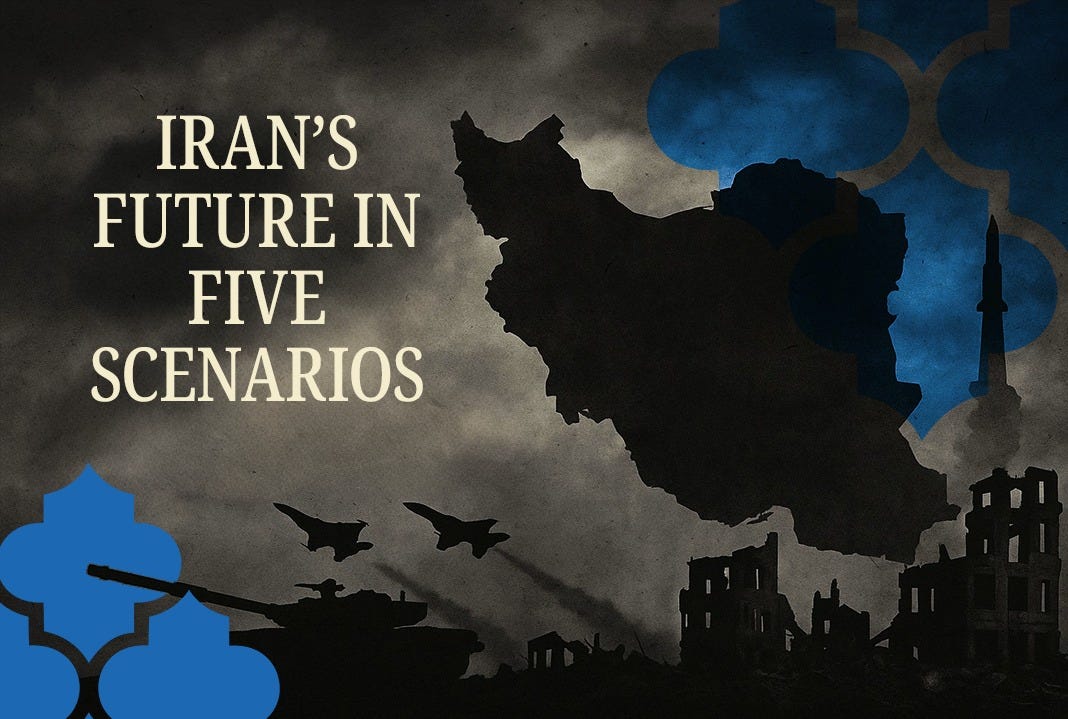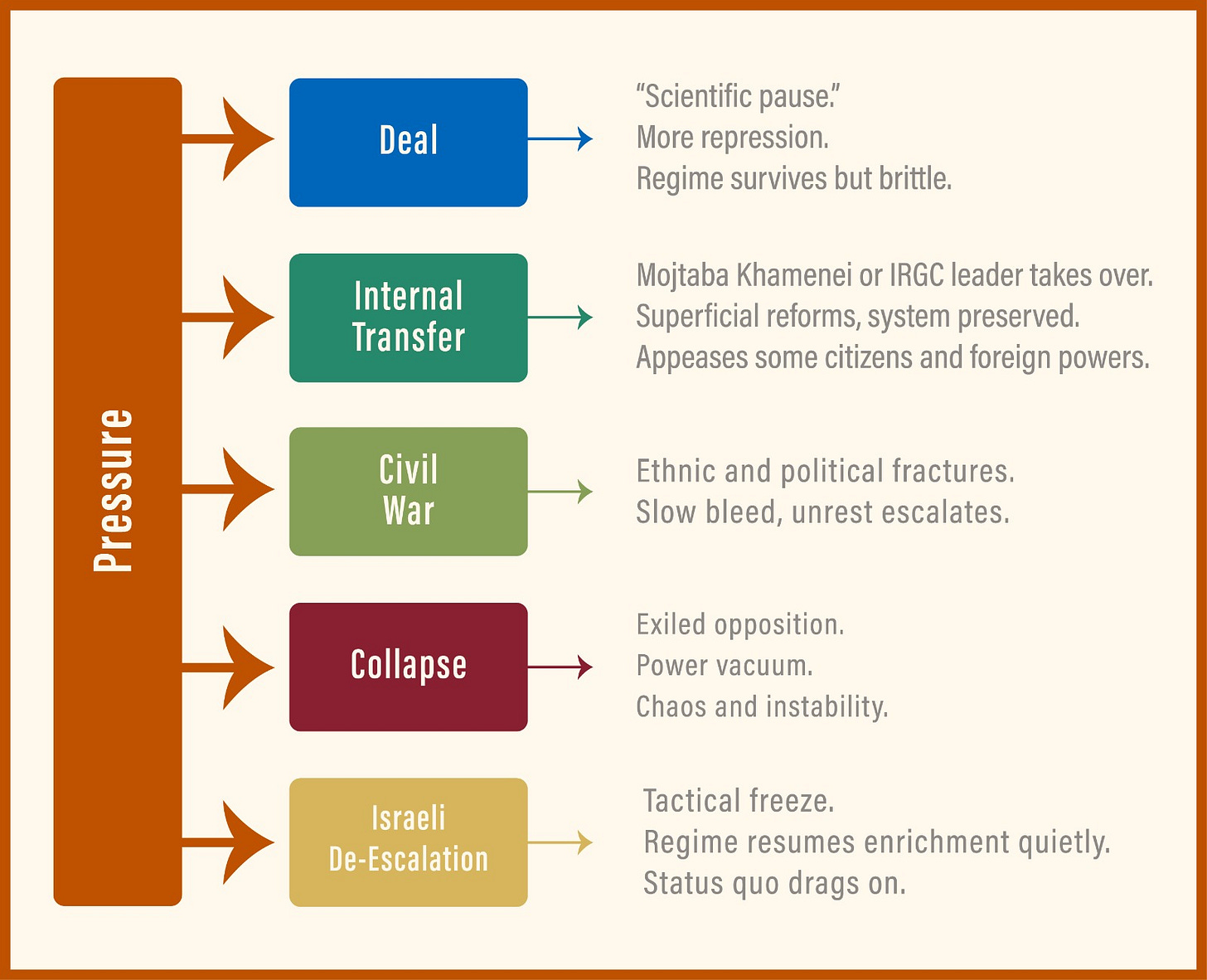Iran’s Future in Five Scenarios
From strategic retreat to regime collapse, the Islamic Republic's volatile trajectory could reshape U.S. policy, Israeli defense strategy, and regional power dynamics
Ask anyone watching Iran closely where the country is headed, and you'll hear a mix of analysis and guesswork. That's because Iran today is in the middle of one of the most fluid and consequential geopolitical gambits in the region. The outcome remains uncertain, but the potential options are narrowing, and the players are growing more desperate. What’s at stake isn’t just the future of the Islamic Republic or the Iranian people. It’s the balance of power in the Middle East, and with it, the long-term shape of U.S. and Israeli strategy.
Below are five scenarios that outline where Iran might be headed, each with an estimated probability based on current dynamics and historical precedent.
The most probable path—call it 40 percent likely—is that the regime cuts a deal.
Under mounting international and domestic pressure, Iran’s leadership could halt uranium enrichment and frame it not as a concession, but a strategic victory. This playbook isn’t new. Think of Gaddafi in 2003: He shelved his nuclear ambitions in exchange for sanctions relief and a few more years in power. Tehran has watched closely—and learned.
But unlike Gaddafi, Iran’s regime is savvier in its messaging. It wouldn’t admit retreat. Instead, it would declare a “scientific pause,” trumpet resistance against Western pressure, and use the breathing room to consolidate control at home. Expect more internet blackouts, tighter repression, and a regime that becomes even more closed and brittle, surviving, but far more insulated and dangerous.
A second scenario—at around 20 percent probability—is a transfer of power from within. This isn’t the democratic revolution many in the diaspora imagine. More likely, someone like Mojtaba Khamenei or a figure from the Islamic Revolutionary Guard Corps takes over, preserving the system while changing its face.
Superficial reforms might follow—enough to appease exhausted citizens and reassure skeptical foreign governments. In this version of the future, Iran looks slightly more rational and technocratic. But the surveillance state stays, the prisons stay, and the ideology remains the same.
This is the outcome many Western analysts quietly prefer: evolution without collapse and stability over uncertainty.
Then there’s the scenario that keeps intelligence officials up at night: civil war.
If internal protests escalate or a shock event—an assassination, a massacre, a military blunder—rips through the system, Iran could fracture. Not just politically, but ethnically and geographically. The Kurds in the northwest, Baluchis in the southeast, Arabs in Khuzestan, and opposition pockets in Tehran itself could erupt into open defiance. The state wouldn’t fall overnight. But it would bleed slowly and brutally, perhaps for years.
This is Iran’s Syria moment, and it's not far-fetched. Like Syria, it wouldn’t begin as a full-blown war. It would start as a wave of unrest that the regime can no longer contain. From there, it could spiral into something worse.
Estimated probability: 20 percent.
There’s also a 10% chance that Israel steps back, not out of a desire for peace, but due to exhaustion. The ongoing shadow war has costs. Israel might pause, reassess, or redirect its efforts elsewhere. This would give Tehran space to resume its nuclear activities just under the radar, carefully avoiding any red lines. The regime would consider this a victory. It wouldn’t be peace, but rather a tactical freeze that allows the status quo to drag on.
Finally, the wild card is the scenario that thrills parts of the diaspora and terrifies Western governments: full regime collapse and the rise of exiled opposition. Maybe a monarchist figure, maybe someone unknown to most Iranians today. It’s the least likely outcome, but it remains on the table at 10% nonetheless. In reality, this would mean a power vacuum, competing factions, and a period of chaos. The fall of the Islamic Republic wouldn’t automatically mean stability. It could mean fragmentation, infighting, or worse.
None of these scenarios is inevitable. They’re probability-weighted outcomes based on current trajectories. But if you want to understand Iran's future, ideology is only part of the equation. So is Western resolve. What matters most is pressure—where it’s applied, how long it lasts, and who’s best prepared to fill the void when something finally breaks.
Middle East Uncovered is powered by Ideas Beyond Borders. The views expressed in Middle East Uncovered are those of the authors and do not necessarily reflect the views of Ideas Beyond Borders.






I think the options are sound, but somewhat constrained by the actions of the US. If America destroys Fordow, there goes most or all of the enriched Uranium and a lot of tech and expertise as they are all likely holed up there. That surely changes some probabilities as Iran then has absolutely no bargaining position and no real military power that can be projected elsewhere. They have enough military to prevent invasion, but their time as a current world influencer would be over.
Hugely insightful article - I feel better informed…